world of weddings
From CentreFold
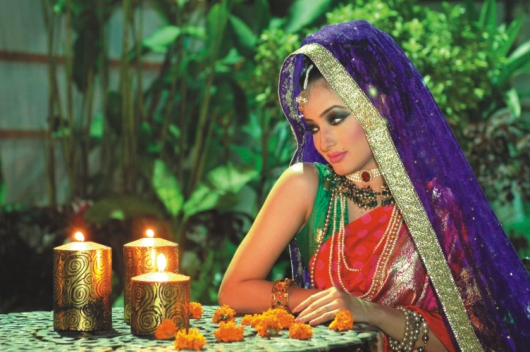
Christian weddings
Anyone who has watched his/her sappy romantic flicks is almost certain to be well informed about the intricacies of the Christian wedding. Everything starting from the selection of the maid of honour and the best man to the ever sweet raising of the veil and finally the words of, “I now pronounce you man and wife,” are concepts that have been done to death by Hollywood.
So without going into further detail and telling you what you already know lets start with the things that we don't. When a man and woman of the Christian faith, want to get married the first thing that they do is of course convince their parents! After 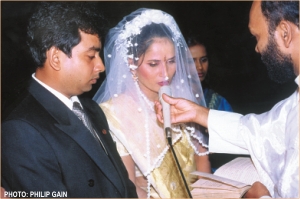 that is done though they need to go to church at least three weeks prior to the wedding date and register with the priest about their marriage. This process, which is called a “ban” is an integral part of the Christian faith and is followed all over the world including by the Bangladeshi Christians. that is done though they need to go to church at least three weeks prior to the wedding date and register with the priest about their marriage. This process, which is called a “ban” is an integral part of the Christian faith and is followed all over the world including by the Bangladeshi Christians.
Why they do this is because, the priest shall then announce on every mass that this man and this woman are getting married and if anyone has any objections they have to come forward and talk to the priest. You know the drill- “ please step forward or forever hold your piece.” Stringent procedures!
The Bangladeshi-Christian wedding ceremony shows a distinct sub-continental flair. As far as dress requirements go there is no flowing wedding gown of your dreams, a sari usually suffices and the men usually stick to wearing suits. One part of the Christian theme that we so like, still remains as the veil retains itself and is a must accessory. As far as colour goes, the bride usually wears gold and white saris. There is no specific colour requirement set, but most families choose to avoid gold.
The wedding takes place understandably in the church and the priest has to wed the lucky twosome. The wedding ceremony follows the mass and the priest weds the two. There is no kissing of the bride here as such close physical contact is probably discouraged in society (read public) at times a little peck by some bold ones is all you see. However there is a lifting of the veil which is preceded by an 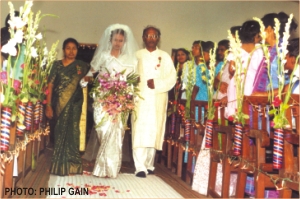 exchange of the wedding vows and that usually brings an end to the ceremony as far as the church is concerned. And for all the expectant ones out there - No! There is no throwing of the bouquet to determine who it is who will get married next. exchange of the wedding vows and that usually brings an end to the ceremony as far as the church is concerned. And for all the expectant ones out there - No! There is no throwing of the bouquet to determine who it is who will get married next.
The wedding at the church is followed by a reception held in a community centre- another aspect borrowed from the sub continental perceptions of weddings. The food is much the same as a typical Bangladeshi wedding with biriyani and burhani on the list of items served. The only extra thing that they have is the wedding cake which is blessed by the priest.
There are other aspects that are seeping into the Christian weddings like the holud and such. But most of these rituals are completely cultural and are add-on's to the religious festivities mentioned in the Bible.
Hindus
The first thing that strikes you about a Hindu wedding is that it is an intensely colourful affair. Such is the élan and panache with which they celebrate their marriage festivals that a lot of their rituals and customs have been borrowed freely by people in this part of the world. It is without a doubt that one can say that the Hindu marriage festival is the dominating one in this part of the world.
Even through all of this it's important to note that a Hindu marriage has a lot of religious implications and is an extremely religious affair.
There are a number of rituals that a Hindu marriage has. Organized chronologically they amount to the:
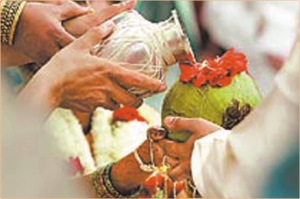 · Vara Satkaarah which is the reception of the bridegroom at the wedding hall where the officiating priest chants a few mantras and the bride's mother blesses the groom with rice and trefoil and applies tilak of vermilion and turmeric powder. · Vara Satkaarah which is the reception of the bridegroom at the wedding hall where the officiating priest chants a few mantras and the bride's mother blesses the groom with rice and trefoil and applies tilak of vermilion and turmeric powder.
· Madhuparka Ceremony - Reception of the bridegroom at the altar and bestowing of presents by the bride's father.
· Kanya Dan - The bride's father gives away his daughter to the groom amidst the chanting of sacred mantras.
· Vivah-Homa - The sacred fire ceremony ascertaining that all auspicious undertakings are begun in an atmosphere of purity and spirituality.
· Pani-Grahan - The groom takes the right hand of the bride in his left hand and accepts her as his lawfully wedded wife.
· Pratigna-Karan - The couple walk round the fire, the bride leading, and take solemn vows of loyalty, steadfast love and life-long fidelity to each other.
· Shila Arohan - The mother of the bride assists her to step onto a stone slab and counsels her to prepare herself for a new life.
· Laja-Homah - Puffed rice offered as oblations into the sacred fire by the bride while keeping the palms of her hands over those of the groom.
· Parikrama or Pradakshina or Mangal Fera - The couple circles the sacred fire seven times. This aspect of the ceremony legalizes the marriage according to the Hindu Marriage Act as well custom.
· Saptapadi - Marriage knot symbolized by tying one end of the groom's scarf with the bride's dress. Then they take seven steps representing nourishment, strength, prosperity, happiness, progeny, long life and harmony and understanding.
· Abhishek - Sprinkling of water, meditating on the sun and the pole star.
· Anna Praashan - The couple make food offerings into the fire then feed a morsel of food to each other expressing mutual love and affection.
· Aashirvadah - Benediction by the elders.
In regards to the celebration of the wedding, the Hindu celebration is originally the one that we usually see in weddings across the city in Bangladesh. It is an elaborate affair that requires a lot of effort most of which is expended by the females.
Of course, in an adapted ceremony like the ones here, great liberties can be taken 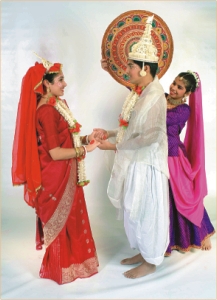 with wardrobe. One rule which shouldn't be broken is that anyone who enters the mandap or wedding canopy must have on sandals or slip-on shoes which can be easily removed. In addition, it's a good idea to avoid much black. with wardrobe. One rule which shouldn't be broken is that anyone who enters the mandap or wedding canopy must have on sandals or slip-on shoes which can be easily removed. In addition, it's a good idea to avoid much black.
One feature of the bride's wardrobe, which has become popular abroad, is the use of henna or mehendi to decorate her hands and feet. It's said that you can tell how well a new bride is being treated by her in-laws from how long it takes for the mehendi to wear off.
Finally, the traditional gift at an Indian/Hindu wedding is money. The amount should be an "auspicious" number ending in 1- so Tk.10,001 is better than Tk 10,000. Cash and check are usually all accepted!
By Quazi Zulquarnain Islam
(The writer acknowledges the help of Bidisha Das and Davina Nelson in the writing of this article)
Photo: Munem Wasif, make-up Farzana Shakil, model Suzanna |

